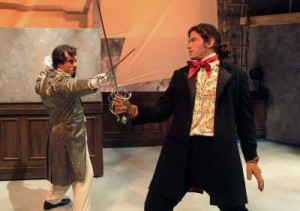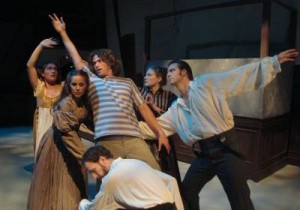NOT RECOMMENDED
The Sight Unseen Theatre Group is one of my favorite local companies. Their
Quarterlife made my “Best of” lists for World Premiere Play, Intimate Theater Play,
and Ensemble. A Year Without Spring, directed by Andy Mitton, was another
fine world premiere drama, with outstanding performances (particularly by Eric
Bloom and Michael Laurino). Then, in a complete turnabout, Sight Unseen put
on a musical, Stephen Sondheim’s Assassins, with AYWS director Mitton wearing
a much different hat, as musical director, Quarterlife star Clark Freeman in the
band, and sets and lighting co-designed by Sam Roberts. Once again, a Sight
Unseen production made my “Best of” list, this time for Intimate Theater
Musical, Now, Roberts, Freeman, and Mitton have combined forces again for
yet another challenge, that of fashioning a 99-seat theater production of
Alexandre Dumas’ classic adventure novel The Count of Monte Cristo, adapted
for the stage and directed by Roberts.
This Count of Monte Cristo looks great, beginning with Haley Powell’s set design.
Sails, like those on the ship Pharon, where young Edmond Dantes was a teenage
sailor, fill the upstage wall, on one of which are projected titles in quill-like script as
introductions to each “chapter.” The sail motif is carried on throughout the
show as “sails” of various shapes and sizes are manipulated by cast members to
become (among other things) a pair of adjoining jail cells, a deathbed, a church,
etc. Dan Jenkins (better known to me as one of our best set designers) has
created a very effective lighting design for this production, and Andy Mitton
(once again wearing a new hat) has composed an epic, mood-setting
background score. Costumes by A. Jeffrey Schoenberg couldn’t be better, a
gorgeous tapestry of 19th century fashion. Jesse Holland has choreographed
some exciting sword fights, and choreographer Peter Schmitz merits high marks
for his inventive creations: actors becoming a ship rocking at sea, waves carrying
Dantes to shore, as well as several opera ballets, which characters watch from
“box seats” stage left and stage right.
Clark Freeman makes a dashing Dantes, and there are some very good
performances among the large cast. Particularly good are Frank Ashmore as
Dumas and a variety of older characters; Brad Grusnick as Danglars, who helps
to bring about Dantes’ imprisonment; Jonathan Nail as prosecutor Villefort; two
Assassin alums, Philip D’Amore (excellent as the evil Fernand) and Jason Decker
(a suave Caderousse); and Melanie Lora, recalling a young Helen Hunt as
Mercedes, Dantes’ first and greatest love. Freeman and Lora have a particularly
effective scene in Act 2, where Dantes confesses his secrets to Mercedes. There
seemed to be opening night jitters among some of the cast members, but these
will hopefully disappear in short order.
I must admit to having been confused by the production’s concept. As the
lights go up, an actor (playing Alexandre Dumas, I believe) passes out folded
sheets of paper to cast members, which appear to be assignments. At first I
assumed that (a la Man of La Mancha), the cast was being informed which roles
they were supposed to play in a reenactment of Dumas’ novel, however a
glance at my program indicated that each was a “scribe.” Were they being
assigned sections of the novel to write/narrate to us? Perhaps this was to allow
actors to play different roles without having to be concerned with looking like
the characters they were portraying. For example, though the novel covers a
period of decades, the actors never age. Dantes at one point is supposed to be
bearded, but Freeman is not. Characters are not supposed to recognize
Dantes, due to his many years in prison, but we see him always as the young and
handsome Freeman. Perhaps the play’s concept was to explain away these
questions?
One other aspect of the production was problematic for me. Men’s roles were
sometimes played by women, but only once, and briefly, near the play’s end, did
a male play a female character (in a brief dance sequence). Why stretch the
audience’s credibility in this way? Also, while the males in the cast cover a wide
range of ages and types, the five women in the cast are all ingénue types,
making it harder to see them in the variety of roles they were called upon to
play, and harder for me to become fully involved in the story.
These qualifications notwithstanding, Sight Unseen Theatre Group deserves
highest marks for its ambitious goals, for the production’s many fine
performances, and the elegant and creative design of the Dumas classic. I look
forward to seeing what’s up next for this company, which reinvents itself with
each new production.
Edgemar Center for the Arts, 2437 Main St. Santa Monica.
www.sightunseentheatre.com
–Steven Stanley
September 21, 2007
Photos: Ed Krieger




 Since 2007, Steven Stanley's StageSceneLA.com has spotlighted the best in Southern California theater via reviews, interviews, and its annual StageSceneLA Scenies.
Since 2007, Steven Stanley's StageSceneLA.com has spotlighted the best in Southern California theater via reviews, interviews, and its annual StageSceneLA Scenies.







 COPYRIGHT 2024 STEVEN STANLEY :: DESIGN BY
COPYRIGHT 2024 STEVEN STANLEY :: DESIGN BY